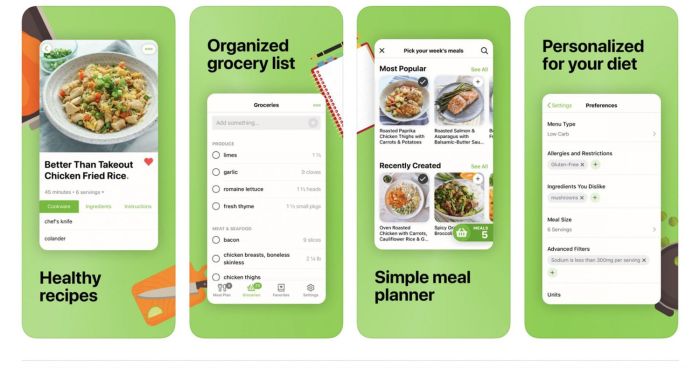Meal planning apps have revolutionized the way we approach food preparation and consumption, transforming a once-tedious chore into a manageable and even enjoyable experience. This analysis delves into the multifaceted world of meal planning applications, examining their market landscape, user needs, technological underpinnings, and monetization strategies.
We will explore the critical features that define a successful app, the challenges inherent in development and scaling, and the crucial role of user experience design in fostering engagement and loyalty. Ultimately, this exploration aims to provide a holistic understanding of this burgeoning sector and its future trajectory.
From the initial market analysis, identifying key players and successful marketing strategies, to a deep dive into user preferences and the technological infrastructure supporting these applications, this study offers a nuanced perspective. We will examine the importance of integrating dietary restrictions, managing recipes effectively, and designing intuitive interfaces.
The discussion will also cover various monetization models, including freemium and subscription-based approaches, and the significance of visual design in creating a compelling user experience. The goal is to paint a comprehensive picture of the meal planning app ecosystem, revealing both its current state and its potential for future growth and innovation.
Market Analysis of Meal Planning Apps
The burgeoning market for meal planning applications reflects a growing consumer interest in health, wellness, and efficient time management. This sector demonstrates significant growth potential, driven by increasing smartphone penetration, rising awareness of dietary needs, and a demand for personalized health solutions.
The convenience and accessibility offered by these apps are key factors in their expanding popularity.
Current Market Size and Growth Potential
The global market for meal planning apps is experiencing robust growth. While precise figures vary depending on the source and definition of “meal planning app,” reports suggest a market valued in the billions, with projections for continued expansion in the coming years.
This growth is fueled by factors such as increasing disposable incomes in developing economies, rising adoption of digital technologies, and a growing preference for home-cooked meals over restaurant dining. The market’s expansion is also influenced by the integration of meal planning apps with other health and wellness platforms, creating a synergistic ecosystem.
For example, the integration with fitness trackers or calorie-counting apps creates a holistic approach to health management. This interconnectedness expands the market’s reach and potential.
Key Players and Comparative Analysis, Meal planning app
Several key players dominate the meal planning app market, each employing distinct features and pricing strategies. Notable examples include Yummly, Mealime, Plantoeat, and others. These apps offer a range of features, such as recipe discovery, personalized meal planning based on dietary restrictions and preferences, grocery list generation, and integration with online grocery delivery services.
Pricing models vary from freemium models (offering basic features for free with premium subscriptions for advanced functionalities) to subscription-based models with varying price points. Competitive advantages are often established through unique recipe databases, superior user interfaces, or innovative features such as AI-powered meal suggestions.
The strategic partnerships formed with grocery retailers further enhance the convenience and appeal of these apps.
Successful Marketing Campaigns
Successful marketing campaigns for meal planning apps often emphasize convenience, personalization, and health benefits. Effective campaigns frequently leverage social media marketing, influencer collaborations, and targeted advertising to reach their intended audiences. For example, a campaign might focus on showcasing the time-saving aspects of the app, highlighting how it simplifies meal preparation and reduces food waste.
Others might concentrate on the app’s ability to support specific dietary needs or goals, such as weight loss or managing specific allergies. The use of compelling visuals and testimonials plays a crucial role in building trust and credibility.
Many successful campaigns also utilize data-driven strategies to optimize targeting and messaging.
Comparative Table of Meal Planning Apps
| App Name | Key Features | Pricing | User Rating (Example) |
|---|---|---|---|
| Yummly | Recipe discovery, dietary filters, grocery list creation, recipe import | Freemium (basic features free, premium subscription available) | 4.5 stars |
| Mealime | Personalized meal plans, grocery list generation, recipe customization, dietary restrictions support | Subscription-based | 4.2 stars |
| Plantoeat | Recipe import, meal planning, grocery list creation, calendar integration | Freemium (basic features free, premium subscription available) | 4.0 stars |
| Eat This Much | Customizable meal plans, dietary restrictions support, recipe suggestions, grocery list creation | Subscription-based | 4.3 stars |
| MyFitnessPal (Meal Planning Feature) | Calorie tracking, macronutrient tracking, recipe database, meal planning integration | Freemium (basic features free, premium subscription available) | 4.6 stars |
Final Review
In conclusion, the meal planning app market presents a dynamic and rapidly evolving landscape. Success hinges on a sophisticated understanding of user needs, a robust technological foundation, and a well-defined monetization strategy. The ability to seamlessly integrate recipe management, accommodate diverse dietary requirements, and create a visually appealing and intuitive user experience are paramount.
As technology continues to advance, we can anticipate even more innovative features, such as AI-powered recommendations and personalized nutrition tracking, further enhancing the capabilities and appeal of these applications. The future of meal planning, therefore, appears bright, driven by ongoing technological advancements and a growing demand for convenient and personalized food management solutions.

